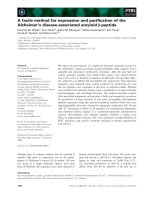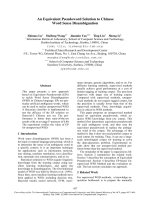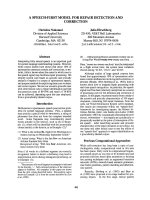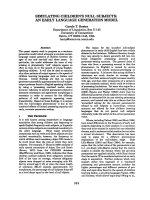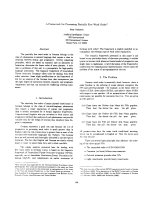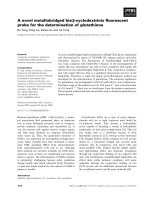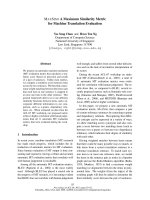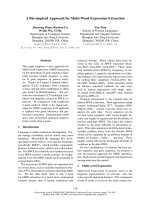Báo cáo khoa học: "a lexicographer''''s workbench supporting state-of-the-art word sense disambiguation" docx
Bạn đang xem bản rút gọn của tài liệu. Xem và tải ngay bản đầy đủ của tài liệu tại đây (241.68 KB, 4 trang )
WASPBENCH:
a lexicographer's workbench supporting state-of-the-art
word sense disambiguation.
Adam Kilgarriff, Roger Evans, Rob Koeling
Michael Runde11, David Tugwell
ITRI, University of Brighton
1 Background
Human Language Technologies (HLT) need dic-
tionaries, to tell them what words mean and how
they behave. People making dictionaries (lexi-
cographers) need HLT, to help them identify how
words behave so they can make better dictionar-
ies. Thus a potential for synergy exists across the
range of lexical data - in the construction of head-
word lists, for spelling correction, phonetics, mor-
phology and syntax, but nowhere more than for
semantics, and in particular the vexed question of
how a word's meaning should be analysed into dis-
tinct senses. HLT needs all the help it can get from
dictionaries, because it is a very hard problem to
identify which meaning of a word applies. Lexi-
cographers need all the help they can get because
the analysis of meaning is the second hardest part
of their job (Kilgarriff, 1998), it occupies a large
share of their working hours, and it is one where,
currently, they have very little to go on beyond in-
tuition and other dictionaries.
Thus HLT system developers and corpus lexi-
cographers can both benefit from a tool for find-
ing and organizing the distinctive patterns of use
of words in texts. Such a tool would be an asset
for both language research and lexicon develop-
ment, particularly for lexicons for Machine Trans-
lation. We have developed the
WAS PB EN CH,
a tool
that (1) presents a "word sketch", a summary of
the corpus evidence for a word, to the lexicogra-
pher; (2) supports the lexicographer in analysing
the word into its distinct meanings and (3) uses
the lexicographer's analysis as the input to a state-
of-the-art word sense disambiguation (WSD) al-
gorithm, the output of which is a "word expert"
which can then disambiguate new instances of the
word.
2
WAS PB ENCH
2.1 Grammatical relations database
The central resource of
WASPBENCH
is a collec-
tion of all grammatical relations holding between
words in the corpus.
WA SPBENCH
is currently
based on the British National Corpus' (BNC): 100
million words of contemporary British English, of
a wide range of genres. Using finite-state tech-
niques operating over part-of-speech tags, we pro-
cess the whole corpus finding quintuples of the
form:
{Rel, W1 , W2, Prep, Pos}
where Rel is a relation, W1 is the lemma of the
word for which Rel holds, W2 is the lemma of the
other open-class word involved, Prep is the prepo-
sition or particle involved and Pos is the position
of W1 in the corpus. Relations may have null val-
ues for W2 and Prep. The database contains 70
million quintuples.
The inventory of relations is shown in Table 1.
There are nine
unary
relations (ie. with W2 and
Prep null), seven
binary
relations with Prep null,
two
binary
relations with W2 null and one
trinary
relation with no null elements. All inverse rela-
tions, ie.
subject-of
etc, found by taking W2 as
the head word instead of W1 are explicitly repre-
1
bnc
211
relation example
bare-noun
the angle of bank"
possessive
my bank'
plural
the banks'
passive
was seen'
reflexive
see' herself
ing-comp
love' eating fish
finite-comp
know' he came
inf-comp
decision' to eat fish
wh-comp
know' why he came
subject
the bank' refused'
object
climb the bank'
adj-comp
grow certain'
noun-modifier
merchant' bank'
modifier
a big' bank
-
and-or
banks and mounds'
predicate
banks are barriers'
particle
grow" up"
Prep+gerund
tired" or eating fish
PP-comp/mod
banks' or the river'
Table 1: Grammatical Relations
sented, giving six extra binary relations
2
and one
extra trinary relation, to give a total of twenty-six
distinct relations. These relations provide a flexi-
ble resource to be used as the basis of the compu-
tations of
WA S PB EN CH .
The relations contain a substantial number of er-
rors, originating from POS-tagging errors in the
BNC, attachment ambiguities, or limitations of
the pattern-matching grammar. However, as the
system finds high-salience patterns, given enough
data, the noise does not present great problems.
2.2 Word Sketches
When the lexicographer starts working on a word,
s/he enters the word (and word class) at a prompt.
Using the grammatical relations database, the sys-
tem then composes a
word sketch
for the word.
This is a page of data such as Table 2, which
shows, for the word in question (W1), ordered lists
of high-salience grammatical relations, relation-
W2 pairs, and relation-W2-Prep triples for the
word.
The number of patterns shown is set by the user,
but will typically be over 200. These are listed
for each relation in order of salience
3
, with the
2
and-or is considered symmetrical so does not give rise
to a new inverse relation.
'Salience is estimated as the product of Mutual Infor-
count of corpus instances. The instances can be in-
stantly retrieved and shown in a concordance win-
dow. Producing a word sketch for a medium-to-
high frequency word takes around ten seconds.
4
2.3 Matching patterns with senses
The next task is to enter a preliminary list of
senses for the word, in the form of some arbitrary
mnemonics, perhaps
MONEY, CLOUD
and
RIVER
for three senses of
bank.
This inventory may be
drawn from the user's knowledge, from a perusal
of the word sketch, or from a pre-existing dictio-
nary entry.
As Table 2 shows, and in keeping with "one
sense per collocation" (Yarowsky, 1993) in most
cases, high-salience patterns or
clues
indicate just
one of the word's senses. The user then has the
task of associating, by selecting from a pop-up
menu, the required sense for unambiguous clues.
Reference can be made at any time to the actual
corpus instances, which demonstrate the contexts
in which the triple occurs.
The number of relations marked will depend on
the time available to the lexicographer, as well as
the complexity of the sense division to be made.
The act of assigning senses to patterns may very
well lead the lexicographer to discover fresh, un-
considered senses or subsenses of the word. If so,
extra sense mnemonics can be added.
When the user deems that sufficient patterns
have been marked with senses, the pattern-sense
pairs are submitted to the next stage: automatic
disambiguation.
2.4 The Disambiguation Algorithm
WASPBENCH
uses Yarowsky's decision list ap-
proach to WSD (Yarowsky, 1995). This is a boot-
strapping algorithm that, given some initial seed-
ing, iteratively divides the corpus examples into
the different senses. Given a set of classified col-
locations, or
clues, and a set of corpus
instances
for the word, the algorithm is as follows:
mation and log frequency. Our experience of working lexi-
cographers' use of Mutual Information or log-likelihood lists
shows that, for lexicographic purposes, these over-emphasise
low frequency items, and that multiplying by log frequency
is an appropriate adjustment.
A set of pre-compiled word sketches can be
seen at
/>adam.kilgarriff/wordsketches.html
212
subj-of
num
sal obj-of
num
sal modifier
num
sal n-mod
num
sal
lend
95
21.2
burst
27
16.4
central 755 25.5
merchant
213
29.4
issue
60
11.8
rob
31
15.3
Swiss
87
18.7
clearing
127
27.0
charge
29
9.5
overflow
7
10.2
commercial
231 18.6
river
217
25.4
operate
45 8.9
line
13
8.4
grassy
42
18.5
creditor
52
22.8
modifies
PP
iv-PP
and-or
holiday
404
32.6
of England
988
37.5
governor of
108
26.2
society
287
24.6
account
503
32.0
of Scotland
242
26.9
balance at
25
20.2
bank
107
17.7
loan
108
27.5
of river
111
22.1
borrow from
42
19.1
institution
82 16.0
lending
68
26.1
of Thames
41
20.1
account with
30
18.4
Lloyds
11
14.1
Table 2: Extract of word sketch for
bank
I. assign instances containing a classified clue
to the appropriate sense
2. for each clue C (already classified or not)
•
for each sense, count the instances
where C holds which are assigned to it
•
identify C's 'preferred' sense P
•
calculate the ratio of C-instances as-
signed to P, to C-instances assigned to
some sense other than P
3. order clues according to the value of the ratio
to give a 'decision list'
4.
assign each instance to a sense according to
the first clue in the decision list which holds
for the instance
5.
if all instances are classified (or no new
instances have been newly classified/re-
classified on this iteration, or some other
stopping condition is met) STOP;
else return to step 2
Yarowsky notes that the most effective initial
seeding option he considered was labelling salient
corpus collocates with different senses. The user's
first interaction with
WASPBENCH
is just that.
At the user-input stage, only clues involving
grammatical relations are used. At the WSD al-
gorithm stage, some "bag-of-words" and n-gram
clues are also considered. Any content word (lem-
matised) occurring within a k-word window of the
nodeword is a bag-of-words clue. (The user can
set the value of
k.
The default is currently 30.)
N-gram clues capture local context which may not
be covered by any grammatical relation. The
n-
gram clues are all bigrams and trigrams including
the nodeword.
Yarowsky's algorithm was selected because it
operated with easily human-readable clues, in-
tegrated straightforwardly with the
WASPBENCH
modus operandi,
and was or was close to being
the highest-performing system in the
SENSEVAL
evaluations (Kilgarriff and Rosenzweig, 2000; Ed-
monds and Kilgarriff, 2002). The algorithm is a
"winner-take-all" algorithm: for an instance to be
disambiguated, the first matching context in the
decision-list is identified, and this alone classifies
the data instance
5
.
3 Evaluation
Evaluation presented a number of challenges:
•
We straddle three communities - commer-
cial dictionary-making, HLT/WSD research,
commercial/research MT - each with very
different ideas about what makes a technol-
ogy useful.
•
There are no precedents.
WASPBENCH
performs a function - corpus-based
disambiguating-lexicon development with
human input - which no other technology
performs. This leaves us with no points of
comparison.
•
On the lexicography front: human analysis of
meaning is decidedly 'craft' rather than 'sci-
ence'.
WASPBENCH
aims to help lexicogra-
phers do their job better and faster. But there
is no tradition for even qualitative, let alone
5
Recent work (Yarowsky and Florian, 2002) has sug-
gested that the winner-take-all strategy is not always the best
strategy if the best clue is not a very good clue. In future work
we would like to extend the
WASPBENCH
to take account of
this insight.
213
quantitative, analysis of performance at this
task, either for speed or quality of output.
• A critical question for commercial MT would
be "does it take less time to produce a word
expert using
WASPBENCH,
than using tradi-
tional methods, for the same quality of out-
put". We are constrained in pursuing this
route, being without access to MT compa-
nies' lexicography budgets or strategies.
In the light of these issues, we have adopted a
'divide and rule' strategy, setting up different eval-
uation themes for different perspectives. We pur-
sued five approaches:
SENSEVAL —
seen purely as a WSD system,
WASPBENCH
performed on a par with the best in
the world (Tugwell and Kilgarriff, 2001).
Expert review —
three experienced lexicogra-
phers reviewed
WASPBENCH
very favourably, also
providing detailed feedback for future develop-
ment.
Comparison with MT —
students at Leeds Uni-
versity
6
were able to produce (with minimal train-
ing) word experts for medium-complexity words
in 30 minutes which outperformed translation of
ambiguous words by commercially-available MT
systems (Koeling et al., 2003).
Consistency of results —
subjects at
IIIT,
Hyder-
abad, India
7
confirmed the Leeds result and estab-
lished that different subjects produced consistent
results from the same data (Koeling and Kilgarriff,
2002).
Word sketches —
lexicographers preparing the
new Macmillan English Dictionary for Advanced
Leaners (Runde11, 2002) successfully used word
sketches as the primary source of evidence for
the behaviour of all medium and high frequency
nouns, verbs and adjectives (Kilgarriff and Run-
dell, 2002).
These evaluations demonstrate that
WASP-
BENCH
does support accurate, efficient, semi-
automatic, integrated meaning analysis and WSD
6
We would like to thank Prof. Tony Hartley for his help in
setting this up.
7
We would like to thank Prof. Rajeev Sangal and Mrs.
Amba Kulkani for their help in setting this up.
lexicon development, and that word sketches are
useful for lexicography and other language re-
search.
The
WA SPBENCH
can be trialled at
http ://w asp s .itri.brighton.ac.uk.
References
Philip Edmonds and Adam Kilgarriff. 2002. Introduction to
the special issue on evaluating word sense disambiguation
systems.
Journal of Natural Language Engineering,
8(4).
Adam Kilgan
-
iff and Joseph Rosenzweig. 2000. Framework
and results for English SENSEVAL.
Computers and the
Humanities,
34(1-2):15-48. Special Issue on SENSEVAL,
edited by Adam Kilgarriff and Martha Palmer.
Adam Kilgarriff and Michael Rundell. 2002. Lexical profil-
ing software and its lexicographical applications - a case
study. In
EURALEX 02,
Copenhagen, August.
Adam Kilgarriff. 1998. The hard parts of lexicography.
In-
ternational Journal of Lexicography,
11(1):51-54.
Rob Koeling and Adam Kilgarriff. 2002. Evaluating
the WASPbench, a lexicography tool incorporating word
sense disambiguation. In
Proc. ICON, International Con-
ference on Natural Language Processing,
Mumbai, India,
December.
Rob Koeling, Adam Kilgarriff, David Tugwell, and Roger
Evans. 2003. An evaluation of a Lexicographer's Work-
bench: building lexicons for Machine Translation. In
Proc. EAMT workshop at EACL03,
Budapest, Hungary,
April.
Michael Rundell, editor. 2002.
Macmillan English Dictio-
nary for Advanced Learners.
Macmillan, London.
David Tugwell and Adam Kilgarriff. 2001. WASPBENCH: a
lexicographic tool supporting WSD. ln
Proc.
SENSEVAL-
2: Second International Workshop on Evaluating WSD
Systems,
pages 151-154, Toulouse, July. ACL.
David Yarowsky and Radu Florian. 2002. Evaluating
sense disambiguation performance across diverse param-
eter spaces.
Journal of Natural Language Engineering,
8(4):In press. Special Issue on Evaluating Word Sense
Disambiguation Systems.
David Yarowsky. 1993. One sense per collocation. In
Proc.
ARPA Human Language Technology Workshop,
Princeton.
David Yarowsky. 1995. Unsupervised word sense disam-
biguation rivalling supervised methods. In
ACL 95,
pages
189-196, MIT.
214
